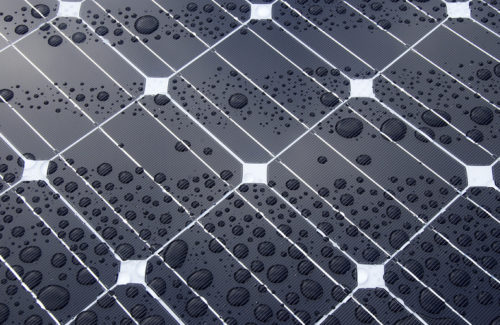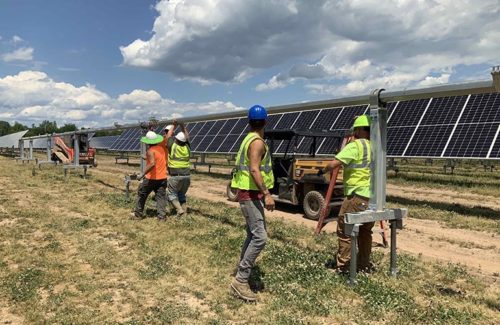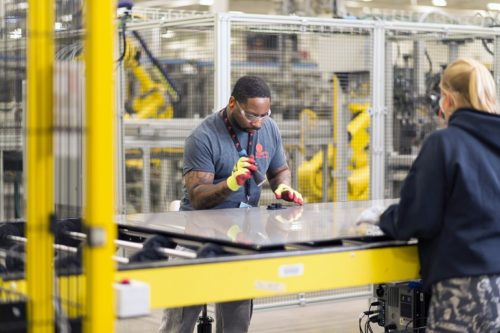It is difficult to separate the hyperbole from the truth as the U.S. solar industry feels the effects of multiple trade issues that will determine its future.
Reporting from Wood Mackenzie suggests that just the Dept. of Commerce’s investigation (not a final ruling) into alleged tariff circumvention by Southeast Asian solar panel manufacturers will eliminate 16 GW of solar panels from the U.S. supply chain — an amount equal to almost the entire volume of utility-scale solar installed across the country in 2021. Advocacy group SEIA is also estimating that the solar industry will lose 70,000 of its 231,000 jobs because of the DOC investigation. Add in continued supply interruptions from a U.S. Customs withhold release order, COVID shutdowns and now a war in Ukraine, and optimism falls further into the background.
Or does it? Is the sky really falling? It depends on what market you’re in and how well you’ve planned for 2022, said the developers, installers and suppliers Solar Power World spoke to. One thing is certain: the second half of this year is going to look a lot different than what everyone predicted.
Future planning in limbo
The latest Chicken Little saga comes amid the DOC investigation, as requested by California-based solar module assembler Auxin Solar. Auxin claims that Chinese crystalline silicon solar panel makers have moved portions of their manufacturing operations to Southeast Asia to circumvent antidumping and countervailing duties (AD/CVD) that have been in place since 2012. Commerce is looking into solar panel operations in Cambodia, Malaysia, Thailand and Vietnam to see if Chinese wafers, aluminum frames, backsheets and more have been used in exported cells and modules. If enough Chinese product is found in Southeast Asian module exports, DOC could extend the AD/CVD to the mentioned countries.
Already, module supply from Southeast Asia — a region that supplied 80% of U.S. demand in previous years — has been limited or completely halted. A survey to SEIA members found that 75% had solar panel deliveries canceled or delayed within a few days of the DOC starting its investigation at the end of March. Almost all those surveyed were predicting this investigation to have a severe or devastating impact on their businesses.
Commerce is expected to present preliminary findings of its investigation on August 30, 2022, along with a preliminary duty rate for all importers of the affected products, should the department find fault. A final decision would then be made on January 26, 2023. That timing of August to January is tricky for those purchasing large quantities of modules, as Q3 2022 is when most begin buying for 2023 projects. Will there be enough supply, and how much will it cost?
Trying to prepare for 2023 is where community solar developer Nexamp is focused right now, said director of supply chain Bilal Ahmed.
“We’re buying so far ahead of time, we’re good almost halfway through 2023, which allows us a couple months of wiggle room,” he said. “But to be able to stay on track, we need to get orders out in the next quarter. We can push the Q2 orders maybe to Q3, however the AD/CVD preliminary decision on this case doesn’t come until August. And even then, if it’s anywhere remotely as vague as it is today or how things transpired in the previous AD/CVD case, if people held out until the very last minute because there was really no direction, we would be forced to make some hard decisions.”
Utility-scale developer Silicon Ranch just signed a 4-GW module supply agreement with U.S. thin-film module manufacturer First Solar, which should ease supply worries through 2025. But CEO Reagan Farr acknowledged that not every major developer has that type of security.
“I’ve seen that 20 to 30% of projects last year didn’t [reach commercial operation date] on time, and I’ve heard that ratio may go up to above 50% this year,” he said. “I think you’re going to see a lot of projects come offline or have to be renegotiated all the way through to the offtake agreement, and that’s going to be impactful to the industry.”
Investing in domestic manufacturing
The main message behind Auxin’s Commerce petition is that Asian solar panel makers are hurting domestic manufacturers. U.S. module companies cannot compete with cheap imports, no matter where they’re from. But most of the industry says continued tariffs are not the solution to these domestic woes.
“These tariffs have been around for 10 years, and we haven’t seen the increase in domestic manufacturing that’s required to meet the demand in the United States,” said Geoff Fallon, COO for utility-scale developer BayWa r.e. Solar Projects. “This isn’t the right mechanism to grow that base. The Dept. of Commerce taking up this investigation is just completely contradictory to the messages coming from the White House.”
The Biden Administration has stated it wants solar to provide 45% of the country’s electricity by 2050, something that is unattainable if domestic manufacturing and foreign solar panel imports are limited.
“We’ve said that tariffs are not the right way to incentivize manufacturing, and that it is going to take time and policy commitment to move manufacturing into the United States at the scale that’s needed,” said SEIA president and CEO Abigail Ross Hopper in a press release.
Big module buyers like Silicon Ranch can help support domestic manufacturing in the meantime by investing in and showing public support for U.S. companies.
“The relationship we signed with First Solar, our focus was wanting increasing percentages of domestic supply. I wanted to incentivize them to continue to invest in U.S. manufacturing. I’ve been doing that not just with my module manufacturer but all of our equipment suppliers where it makes sense,” Farr said. “These dialogues didn’t start yesterday. They started a year and a half ago. Why are we buying steel from Asia? Surely, we can make steel and do make steel in the U.S. Trying to lock down and create aligned incentives with our equipment suppliers is a meaningful thing the industry needs to do.”
Nexamp is doing the same to secure some supply, albeit a smaller amount for the commercial developer averaging 100 MW of installations each year.
“We’re able to get American supply, but it’s a drop in the bucket for what the need is across the board,” Ahmed said. “We have a couple local manufacturers we’re working with. We’re doing extensive master service agreements where we’re investing, trying to help them out with where we can add value outside of a straight cash deal.”
Shifting focus
No matter the outcome of the Dept. of Commerce’s decision, the rest of 2022 will be unpredictable for all markets, said David Dunlap, VP of operations for distributor BayWa r.e. Solar Systems.
“Residential will fare better than utility, but it will not be unscathed by a long shot,” he said. “Fear and uncertainty is its own disrupter. Even if people can continue to get product, just acting from a place of reactive, fear-based decision making is never a good thing.”
The residential market has another bump in the road, with popular solar panel brand LG exiting the market this June.
“There’s no doubt that there’s a big gap in the residential market. And that gap isn’t easily closed when you have these competing issues like WRO, AD/CVD, rising prices, supply chain constraints,” Dunlap said. “I encourage people to assess their own business resilience and business agility. If they were heavily dependent on this high-risk-profile product, what could you do to change to a different opportunity?”
 Dunlap suggests installers split their business tasks into short-term and long-term thinking. Short-term is everything that needs to be done in the next month, while the backlog is considered long-term. It’s less stressful to track down 1,000 modules needed for the next month than 12,000 modules needed for the full year. Being realistic is just as advantageous, too.
Dunlap suggests installers split their business tasks into short-term and long-term thinking. Short-term is everything that needs to be done in the next month, while the backlog is considered long-term. It’s less stressful to track down 1,000 modules needed for the next month than 12,000 modules needed for the full year. Being realistic is just as advantageous, too.
“Maybe your install rate doesn’t need to grow as fast this year as you originally planned. What happens if you continue that aggressive plan and you continue to disappoint customers because you can’t show up and install?” Dunlap said.
Instead of trying to hit aggressive solar sales goals, the rest of the year could be focused on growing adjacent offerings like EV charging and battery backup.
“Now is a great time to get back to your installed base and add storage to those customers,” Dunlap said. “You’ve never had time to make those calls and talk to people about it. Maybe that’s long-term thinking you can’t do when you’re solving the short-term problems.”
This year’s successful solar contractors will turn trade squabbles and supply issues into opportunities to better focus their businesses for the future — and the next hill on the solarcoaster.








““We’re buying so far ahead of time, we’re good almost halfway through 2023, which allows us a couple months of wiggle room,” he said. “But to be able to stay on track, we need to get orders out in the next quarter.””
There may be a major problem this time around with this new AV/CDV case this time is being proposed as a “retroactive” tariff. SO, last time it was “telegraphed” that tariffs were coming, and many solar PV firms got smart and loaded up with very large Chinese manufactured panels at great prices in the $0.17/watt range for product runs at or over 100K panels. They warehoused them and met their customers’ needs as they came along. This time around, it looks like if you have it on the warehouse shelf, you will still pay a tariff on the panels or installation products from Maylasia. Where solar PV companies may NOT get gigged, is IF they bought solar PV bi-facial panels and have these units warehoused waiting for customers and their projects. It seems that bi-facial panels aren’t under the 201 tariffs.
My company’s biggest issue in out market area of Kansas City is getting installers..both experienced and non.
Really good news piece and look at what’s ahead with this antidumping cast and our SolarCoaster we continue to ride, as always, adapt and diversify as needed 🙂